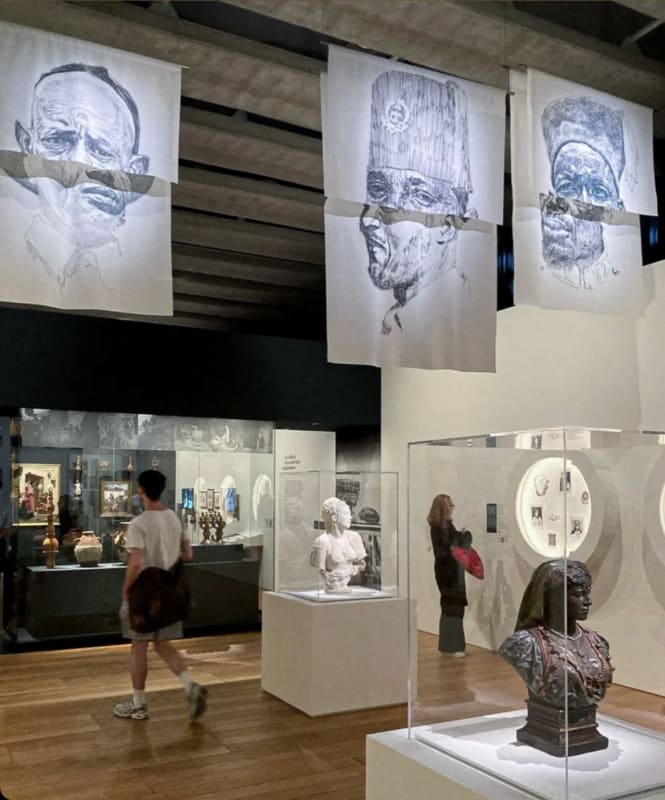Mediterraneans
Episode 1: Inventions and representations
Mucem, the history of the plural and fantasized “Mediterraneans”...
The Mucem is the only society museum whose scientific project is fully dedicated to the cultures of the Mediterranean. On the occasion of its 10th anniversary, it invites us to discover the richness of its European and Mediterranean collections through a new permanent exhibition. From Greco-Latin Antiquity to the present day through the colonial period, it immerses us in the history of the plural and fantasized “Mediterraneans”.
This permanent exhibition is divided into several episodes, intended to renew its presentation until 2030: “Mediterranese” will be regularly enriched with new masterpieces from the history of art, new treasures from the collections and new rare pieces, recently acquired or loaned, opening new paths and new courses to embrace these Mediterraneans. Indeed, the imaginations of the Mediterranean are multiple, and not all of them can be shown in a single exhibition. “Mediterraneans” questions the way in which these imaginations were formed and disseminated, and in particular the role of museums, by discovering how the history of the arts and ethnology contributed to creating “images” of the Mediterranean, all relative and all constructed.
In fine arts museums, it is the civilizations of the past, in particular those of Antiquity, which are first highlighted and which construct a dream Mediterranean nourished by Homer's Odyssey, Greek temples and stories about Rome and Palmyra.
Ethnographic museums, which appeared during the colonial period, were interested in geographically or culturally “distant” societies. The sincerity of scientific and human interest in the Other rubs shoulders with the interests and businesses of the colonial powers.
The distinction between fine arts museums and ethnographic museums has created boundaries between the objects they house and the disciplines that study them. The Mucem today wishes to go beyond these boundaries and highlight the parallels and mutual influences that exist between these two types of museums. Following this idea, “Mediterranese” combines different historical museographic models, from the dense hanging of fine arts museums of the late 18th and 19th centuries, to the different forms of presentation used throughout history by ethnographic museums.
The exhibition presents more than 300 objects and documents, half of which come from the Mucem collections. Throughout the route, works of contemporary art evoke today's issues in the Mediterranean. They were created by the artists Francis Alÿs, Ziad Antar, Hélène Bellenger, Nidhal Chamekh, Joseph Eid (AFP), Nina Fischer & Maroan el Sani, Mouna Karray, Fatima Mazmouz, Selma and Sofiane Ouissi, Maria Varela, as well as Théo Mercier, the latter having been invited to “infiltrate” the exhibition route with the kind participation of the Department of Underwater and Underwater Archaeological Research (DRASSM).
The deposits come from around twenty institutions: Quai Branly Museum – Jacques Chirac, Orsay Museum, Louvre Museum, National Library of France, Heritage Media Library, Paris School of Fine Arts, Palace of Versailles Museum , General Council of Seine-Saint-Denis, Museum of National Archeology, Museum of Fine Arts of Marseille, Museon Arlaten, Museum of Fine Arts of Bordeaux, Museum of Fine Arts of Valenciennes, Museum of Fine Arts of Angers, Museum of Fine Arts of Laval, Denys-Puech Museum of Rodez, Museum of Art and History of L'Isle-Adam, Museum of Casts of the Lumière Lyon 2 University, Lugdunum Museum and Roman theaters, Workshops of art, casts and chalcography from the Meeting of National Museums – Grand Palais, Benaki Museum in Athens, Museum of Photography in Thessaloniki, Museum of the History of Greek Costume in Athens, the Mor Carpenter Gallery.
 Affiche de l'exposition "Méditerranées" © Mucem
Affiche de l'exposition "Méditerranées" © Mucem

